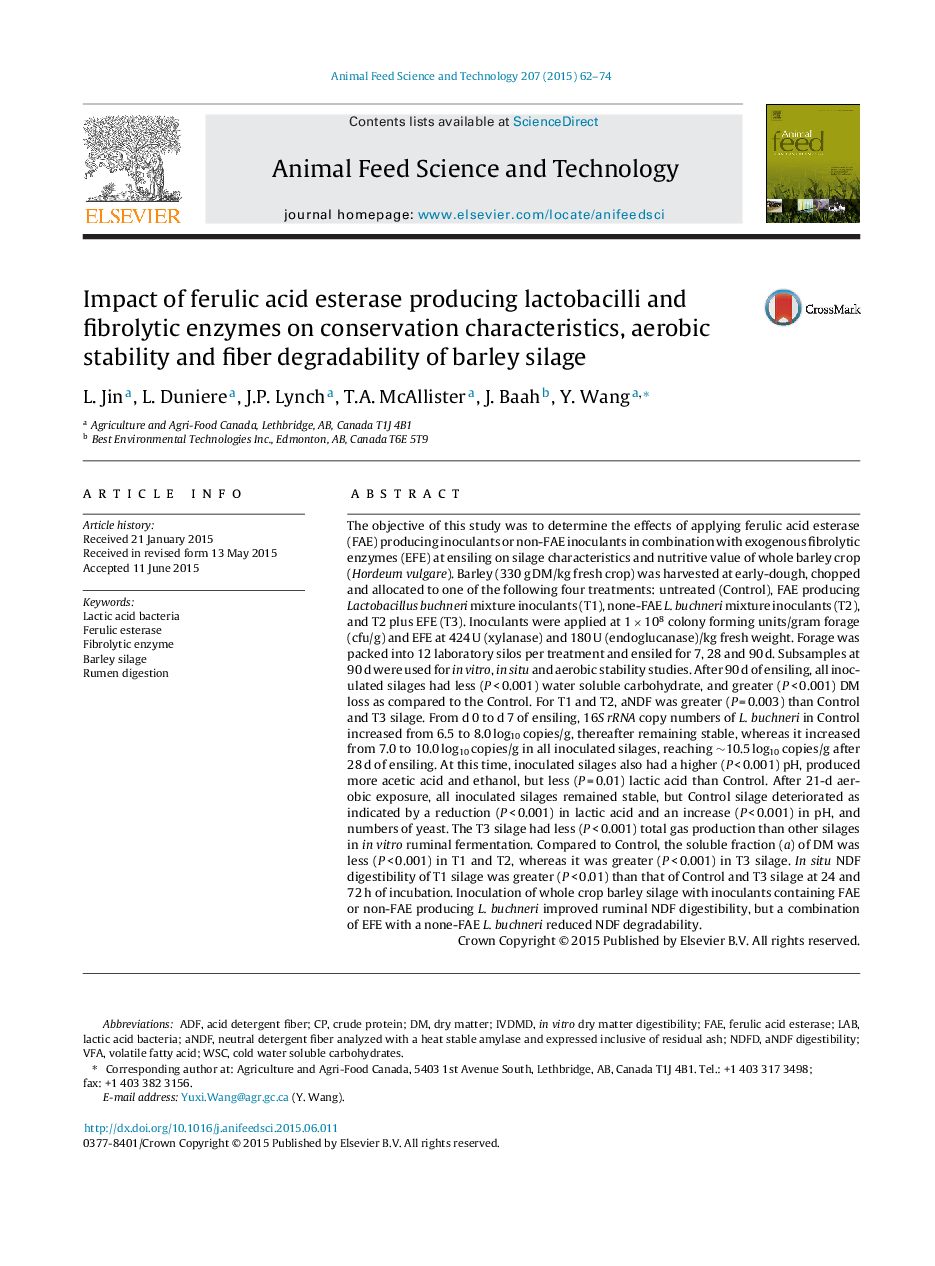| کد مقاله | کد نشریه | سال انتشار | مقاله انگلیسی | نسخه تمام متن |
|---|---|---|---|---|
| 2419437 | 1552378 | 2015 | 13 صفحه PDF | دانلود رایگان |
• L. plantarum and L. buchneri based inoculant increased initial ensiling fermentation.
• L. buchneri improved aerobic stability.
• FAE produced by FAE-producing L. buchneri is active during early ensiling.
• FAE-producing L. buchneri inoculant improved ruminal fiber digestibility.
• Co-inoculating enzyme and non-FAE producing inoculant reduced fiber digestibility.
The objective of this study was to determine the effects of applying ferulic acid esterase (FAE) producing inoculants or non-FAE inoculants in combination with exogenous fibrolytic enzymes (EFE) at ensiling on silage characteristics and nutritive value of whole barley crop (Hordeum vulgare). Barley (330 g DM/kg fresh crop) was harvested at early-dough, chopped and allocated to one of the following four treatments: untreated (Control), FAE producing Lactobacillus buchneri mixture inoculants (T1), none-FAE L. buchneri mixture inoculants (T2), and T2 plus EFE (T3). Inoculants were applied at 1 × 108 colony forming units/gram forage (cfu/g) and EFE at 424 U (xylanase) and 180 U (endoglucanase)/kg fresh weight. Forage was packed into 12 laboratory silos per treatment and ensiled for 7, 28 and 90 d. Subsamples at 90 d were used for in vitro, in situ and aerobic stability studies. After 90 d of ensiling, all inoculated silages had less (P < 0.001) water soluble carbohydrate, and greater (P < 0.001) DM loss as compared to the Control. For T1 and T2, aNDF was greater (P = 0.003) than Control and T3 silage. From d 0 to d 7 of ensiling, 16S rRNA copy numbers of L. buchneri in Control increased from 6.5 to 8.0 log10 copies/g, thereafter remaining stable, whereas it increased from 7.0 to 10.0 log10 copies/g in all inoculated silages, reaching ∼10.5 log10 copies/g after 28 d of ensiling. At this time, inoculated silages also had a higher (P < 0.001) pH, produced more acetic acid and ethanol, but less (P = 0.01) lactic acid than Control. After 21-d aerobic exposure, all inoculated silages remained stable, but Control silage deteriorated as indicated by a reduction (P < 0.001) in lactic acid and an increase (P < 0.001) in pH, and numbers of yeast. The T3 silage had less (P < 0.001) total gas production than other silages in in vitro ruminal fermentation. Compared to Control, the soluble fraction (a) of DM was less (P < 0.001) in T1 and T2, whereas it was greater (P < 0.001) in T3 silage. In situ NDF digestibility of T1 silage was greater (P < 0.01) than that of Control and T3 silage at 24 and 72 h of incubation. Inoculation of whole crop barley silage with inoculants containing FAE or non-FAE producing L. buchneri improved ruminal NDF digestibility, but a combination of EFE with a none-FAE L. buchneri reduced NDF degradability.
Journal: Animal Feed Science and Technology - Volume 207, September 2015, Pages 62–74
